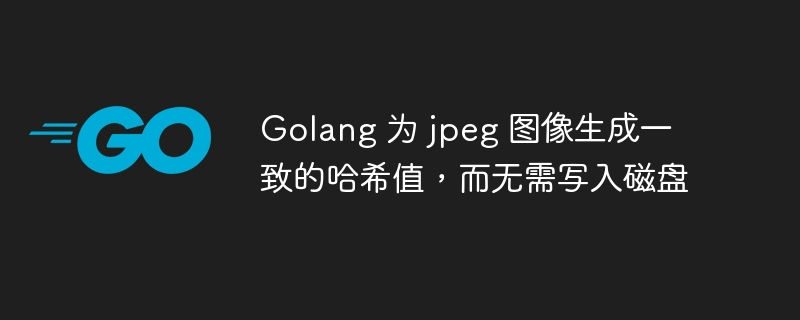
在开发过程中,我们经常需要比较图像文件的相似度,以便进行图像识别、去重等操作。而生成图像的哈希值是一种常见的方法。通常,我们需要将图像写入磁盘,再读取出来进行哈希计算。然而,使用Golang编程语言,我们可以轻松地实现在生成jpeg图像的同时,直接计算出一致的哈希值,而无需写入磁盘。这为我们节省了时间和磁盘空间,提高了效率。本文将详细介绍如何在Golang中实现这一功能。
golang 成像新手
我正在尝试为 jpeg 图像生成一致的哈希值。 当我以 JPEG 格式写入磁盘(这是预期的)后重新加载图像时,加载图像并在原始字节上生成哈希值会产生不同的哈希值。一旦我将 RBGA 作为 JPEG 写入磁盘,像素就会被修改,这会破坏我之前计算的哈希值。
仅对文件 hash("abc.jpeg") 进行哈希处理就意味着我必须写入磁盘;读回;生成哈希值等..
// Open the input image file
inputFile, _ := os.Open("a.jpg")
defer inputFile.Close()
// Decode the input image
inputImage, _, _ := image.Decode(inputFile)
// Get the dimensions of the input image
width := inputImage.Bounds().Dx()
height := inputImage.Bounds().Dy()
subWidth := width / 4
subHeight := height / 4
// Create a new image
subImg := image.NewRGBA(image.Rect(0, 0, subWidth, subHeight))
draw.Draw(subImg, subImg.Bounds(), inputImage, image.Point{0, 0}, draw.Src)
// id want the hashes to be the same for read / write but they will always differ
hash1 := sha256.Sum256(imageToBytes(subImg))
fmt.Printf("<---OUT [%s] %x\n", filename, hash1)
jpg, _ := os.Create("mytest.jpg")
_ = jpeg.Encode(jpg, subImg, nil)
jpg.Close()
// upon reading it back in the pixels are ever so slightly diff
f, _ := os.Open("mytest.jpg")
img, _, _ := image.Decode(f)
jpg_input := image.NewRGBA(img.Bounds())
draw.Draw(jpg_input, img.Bounds(), img, image.Point{0, 0}, draw.Src)
hash2 := sha256.Sum256(imageToBytes(jpg_input))
fmt.Printf("--->IN [%s] %x\n", filename, hash2)
// real world use case is..
// generate subtile of large image plus hash
// if hash in a dbase
// pixel walk to see if hash collision occurred
// if pixels are different
// deal with it...
/// else
// object.filename = dbaseb.filename
// else
// add filename to dbase with hash as the lookup
// write to jpeg to disk您可以使用哈希作为编写器的目标,并使用 io.MultiWriter 在写入文件时计算哈希:
hash:=sha256.New() jpeg.Encode(io.MultiWriter(file,hash),img,nil) hashValue:=hash.Sum(nil)
以上是Golang 为 jpeg 图像生成一致的哈希值,而无需写入磁盘的详细内容。更多信息请关注PHP中文网其他相关文章!




